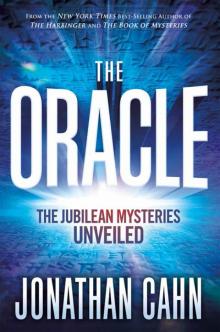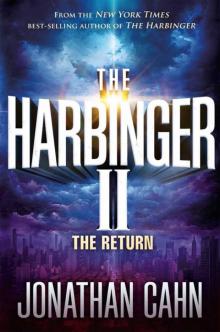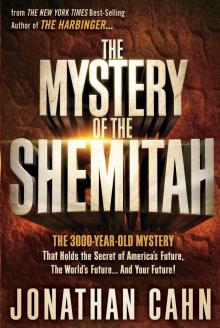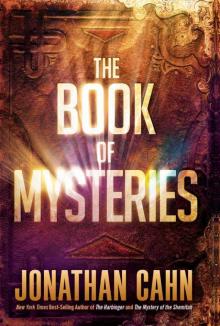- Home
- Jonathan Cahn
The Harbinger II Page 5
The Harbinger II Read online
Page 5
Raise up the city that is lowered to the dust. . .”7
“So it just happened,” I said, “that those words were appointed from past ages to be recited on the days of the calamity.”
“Or the calamity just happened to fall on the days of the appointed words. So on the morning of 9/11, when the nation’s Defense Department had no idea what was about to happen, the ancient words were being recited of the attack of a nation and its city by its enemies. And the words were being spoken especially on the nation’s East Coast and in New York City that morning where the attack would take place. The reciting of the selichote was to be completed by daybreak. And so on 9/11, it was in the last hour of the utterance of those ancient words of judgment that the terrorists of 9/11 set the attack in motion. Daybreak came to New York City at approximately 6:30. The prayers appointed for the day of calamity were now completed. Within fifteen minutes of that moment, the terrorists arrived at Logan Airport in Boston, from which they would launch the nation’s calamity.”
“The next mystery would take me onto a centuries-old ship on a voyage that would uncover the secret of 9/11 . . . in a mystery of time.”
Chapter 8
Foundations
IN THE NEXT dream, I found myself standing inside a large house, a mansion. Everything inside the house was large, grand, ornate, and luxurious, the rooms, the furniture, the chairs, the wooden doors and tables, the curtains, the golden chandeliers. I had never before been in such an opulent setting.
“Then I heard a rumbling. The house and everything in it began to shake. And then the floor on which I was standing gave way. Everything collapsed. I went down with the house but in a way that seemed to defy gravity . . . slowly, as if I were floating down in the midst of a collapse that appeared to be happening in slow motion. As I descended, I became aware that the house had many floors, all of which were collapsing around me.
“Finally, my feet touched the bottom. I was standing at the ground level, at the building’s foundation, watching everything else come down around me. And then it was over. I began walking through the ruins. I noticed a piece of stone jutting out. I was drawn to it. I began clearing away the debris that partially obscured it. It was a foundation stone. But it didn’t match the rest of the building. It seemed to be from an earlier age. As I continued uncovering it, I noticed letters, words, carved into its surface.”
“What did it say?”
“Before I could read it, everything disappeared, the ruins, the debris, everything except the foundation itself. But now the foundation was moving, rocking. I heard the sound of waves and seagulls. The foundation had transformed into the deck of a ship, a centuries-old ship, with sails and wooden masts. Everything was wooden except for the deck, which was still of the stone from the building’s foundation.
“I wasn’t alone. There were others on board, crewmen, all of whom were dressed in clothing from, I would guess, five or six centuries in the past. The ship was moving slowly through a passageway. I don’t know if we were navigating through a river or not, but there was land on both sides.
“Then I heard a voice. Standing beside me was the prophet.”
“What happens,” he asked, “when a building is destroyed? What is it that is then exposed?”
“Its foundation.”
“So God laid the foundation stone on which Israel rose as a nation. But at the height of its blessings, it turned away and was corrupted. Its cities were filled with immorality, its streets with bloodshed. Again and again, God called the nation to return, but it only grew more defiant and evil. So He said this:
I will break down the wall you have plastered with untempered mortar, and bring it down to the ground, so that its foundation will be uncovered.1
“The words were first addressed to the lies of the false prophets of Israel who assured the nation that no calamity would come. Their lies would be undone. But so too would be the nation. It would be broken down to the ground. God would undo what He had built. He would strip away all that had risen on top of the foundation He had laid. He would bring everything back to its foundation. It is a principle of judgment: the nation will be brought back to its foundation.”
“The falling tower,” I said, “was it a symbol of America?”
“Yes, a high and proud tower and far removed from the foundation on which it began.”
“And on 9/11, the high tower crumbled back to its foundation. It was brought ‘down to the ground.’ Its foundation was uncovered.”
“But there’s more to the mystery. The high tower of America rests on two earthly foundations, its economic power and its military power. Of the two, it was its economic power that was the first to rise. Long before American soldiers could be found in every corner of the earth, the nation’s economic power had already encircled the world. And long before there even was an American military power, the foundation on which its economic power would rise had been laid.”
“Where?” I asked. “Where was the foundation laid?”
“The center of America’s economic power and of the nation’s rise to economic superpower was New York City. And when was its foundation laid? When did that which we now know as New York City begin?”
“I don’t know.”
“In the foundation of the city is ultimately the foundation of that power. The day the one began, so did the other.”
“Can we find that day?”
“Perhaps he can,” said the prophet, pointing to a lone figure in a long black coat standing at the front of the ship, gazing out into the waters.
“Who is he?” I asked.
“The ship’s captain.”
“Where are we?” I asked.
“On a voyage in search of a passage.”
“What ship is this?”
“It belongs to the Dutch East India Company. The captain’s name is Henry Hudson.”
“Henry Hudson! I learned about him in elementary school.”
It was just then that the man in the long black coat pointed into the distance and said something to the crew that caused them to look into the distance.
“And now you’ll see,” said the prophet, “the mystery of the foundation, the day it all began.”
The ship was heading toward the tip of a land mass.
“It’s an island,” said the prophet.
“Is that it?” I asked. “Is that New York City?”
“It’s the beginning,” he said, “of what would become New York City, the island known as Manhattan.”
“So this is the day of its discovery.”
“Yes.”
I watched as the ship approached the island and anchored by its shore.
“This, Nouriel, is the day it all began, the beginning of the city, the power, and the rising. This is the day of the foundation.”
“And the mystery is . . . ”
“The day itself.”
“Which is what?”
“September 11.”
“September 11!”
“It all began on September 11. September 11 is the day New York City was born.”
“Its birthday . . . So the city was struck on the day of its birth.”
“And the rise of America’s economic power—it all began on September 11.”
“So on the day of the rising . . . came the fall.”
“And it was this power that was before and behind the nation’s other powers and the rise of the nation itself. So all those other powers have their origins on 9/11 . . . as does the rise of America itself. It all began on 9/11.”
“So it all converged; it all came back to that same day.”
It was then that the captain picked up a large rectangular block of stone that was sitting on the deck and carried it off the ship and onto the shore of the island. The prophet and I followed behind.
“I would think,” I said, “that the stone is too big for a man to carry. Did Henry Hudson actually carry a stone ashore?”
“No, Nouriel,” said the prophet. “This is a drea
m. The discovery and founding of this island actually happened. But what you’re seeing now is symbolic.”
We followed him to a site near the water’s edge, where he set the stone on the ground. He then took out a hammer and chisel and began engraving letters into the stone’s top side.
“It’s the stone,” I exclaimed, “the stone in the dream!”
“This is the dream,” said the prophet. “You’re still in it.”
“The stone that was exposed at the building’s foundation after the collapse.”
“Yes. Would you now like to read what it says?”
“Yes.”
So he led me over to the stone, and I read the engraving.
“Ezekiel 13:14,” I said. “What does it mean?”
“Ezekiel 13:14 is the verse that speaks of the breaking down of the wall and the uncovering of its foundation.”
“The fall of the house exposes its foundation.”
“Put it together, Nouriel. What happened to Israel in its day of judgment?”
“Its powers were broken,” I replied. “Its buildings came down. Everything was stripped away. And the foundation was exposed.”
“Yes, on the day of judgment the nation is brought back to its foundation.”
“And so on 9/11, America was brought back to its foundation. Through the calamity the nation’s foundation was exposed.”
“It is not only that America returned to its foundation on 9/11—it’s that America’s foundation itself is 9/11. Long before it became a day of calamity, 9/11 was the day of America’s foundation.”
“The mystery of 9/11 . . . I never would have imagined that.”
“A convergence of times. It happened in the judgment of ancient Israel. When the Temple of Jerusalem was destroyed by the armies of Rome, it happened on the same day that the first Temple of Jerusalem was destroyed by the armies of Babylon, centuries before—the same exact day.”
“And those who destroyed it—did they do it because . . . ?”
“No. It just happened. Nor did the terrorists of 9/11 have any idea. They simply came to bring destruction.”
“So it wasn’t only what happened on 9/11 that was the sign—it was 9/11, the day itself, that was the sign.”
“In the Book of Jeremiah, the nation’s judgment was prophesied in these words:
What I have built I will break down, and what I have planted I will pluck up.2
“Notice what happens when judgment comes: the breaking down is joined to the building up, the uprooting is joined to the planting. Each is joined to its inverse, its opposite . . . the mystery of inversion.”
“So 9/11 was the day that New York City was planted. So it became the day of uprooting. And on the day that began its building. . . came the day of the breaking down.”
“And what is the meaning,” I asked, “and the message?”
“As it was with ancient Israel, America’s blessings came from God, its economic blessings, its financial blessings, its prosperity, the fruit of its baskets, the bread of its kneading bowls, its power to produce wealth, and its reign as the most prosperous of nations—it all came from God. But if America should repeat the error of ancient Israel and turn against the foundation of all its blessings, how long, then, can those blessings endure?”
“Ana, you haven’t said a word or even given me a hint of an expression so I might know what you’re thinking.”
“When it all happened,” she said, “when America came to a standstill on 9/11, I can still remember what I was thinking, but I never could have imagined that behind all those things, all that was going on.”
The two sat in silence for a time, Nouriel sipping on his glass of water and Ana just sitting there.
“So what happened next?” she asked. “What was the next revelation?”
“The next dream would take me deeper into the mystery and would involve a man, a microphone, and an eagle in a mystery that would change the world.”
Chapter 9
The Night Address
IT WAS NIGHT. I was passing over a landscape of houses, towns, villages, then cities, and then more towns and villages.”
“Passing over?”
“Passing over, flying, or being shown all these things as if I were. But more striking than what I was seeing was what I was hearing.”
“Which was?”
“A voice, the same voice coming from every town and city, from every building and home.”
“What kind of voice?”
“The voice of a man, as if delivering a speech. The voice continued as I passed over a city of monuments and buildings of white stone that resembled classical temples. It was then that I began descending, touching the ground in the midst of that city.
“In front of me was a long series of massive white stone steps leading up to a platform. On top of the platform was a desk.”
“A desk?”
“A desk of stone or a large rectangular stone that served as a desk and of the same color and appearance as the stone I saw in the other dream at the foundation of the building. Behind the desk sat a man.”
“What did he look like?”
“He appeared to have been in his sixties, wearing glasses, a light-colored jacket, a dark tie, and a black armband in between his left shoulder and elbow. In back of the man, a good way back, was a colossal stone building of the same color and appearance as the desk. And even though it was set back, it was tall enough to be visible from the bottom of the stairs. Engraved on its front wall was the image of a colossal eagle with outstretched wings, several stories high.”
“How could you make it out at night?”
“There were lights stationed everywhere. And they allowed me to make out another detail: resting on top of the desk was a cluster of microphones, but of stone, the same stone of which the desk was made. It was then I realized what I was seeing. The man was speaking into the microphones. And it was his voice that was filling every home, town, and city, filling the land. And it was then that I heard him.”
“The man at the desk.”
“No, the prophet.”
“On the day of calamity, the foundations are exposed,” he said. “9/11 exposed the foundation of America’s fundamental powers. But there were two. What about the other?”
“America’s military power?”
“Yes, its military power. The rise of American economic power was gradual and continuous. But the rise of its military power came differently, dramatically and suddenly. It was the Second World War that transformed America into the world’s greatest military power. And it was that power that ushered in a new era of world history. How did it happen?”
“I would imagine you’ll tell me.”
“It was in the late 1800s that America overtook the British Empire to become the world’s leading economic and industrial power. But its military power was relatively weak. Its army was a small fraction of the size of the British army.
“In 1917 America was drawn into the First World War and only for the last phase of that war. When the conflict was over, the nation began withdrawing from foreign involvement and toward isolationism. Its isolation would last through the 1920s and 1930s, even with the rise and growing danger of Fascism and Nazism. In the mid- to late 1930s, the American Congress passed several neutrality acts, which barred or severely limited the nation from any involvement in the conflicts of other nations. With the outbreak of the Second World War, the American president, Franklin Roosevelt, sought to lead the nation out of isolationism and into war against the forces of Nazism and Fascism that were then engulfing the European continent. But he was fighting against public opinion and the resistance of the United States Congress.
“The turning point concerning America’s entrance into the Second World War and thus its rise to global superpower came in 1941. In February of that year, Life magazine published an editorial calling for the end of American isolation and the beginning of what it called ‘the American century.’1 The next month, Congress passed the Lend
-Lease Act, which allowed massive aid to go toward assisting Allied nations in their war efforts. As a protective measure, in April, Roosevelt authorized the stationing of American troops in Greenland, and three months later troops were sent to Iceland. In August, Roosevelt and the British prime minister, Winston Churchill, met secretly off the coast of Newfoundland, where they formulated a statement of eight shared goals for a postwar world in what would be seen as the beginning of the British-American alliance and known as the Atlantic Charter. But to Churchill’s disappointment, Roosevelt refused to commit to entering the war. Without the support of Congress and public opinion, his hands were tied.
“But that would soon change. And the change would come in late summer when a US Navy Ship, the USS Greer, was fired on by a German submarine it had been following. It fired back in turn with depth charges. It was the first time an American Navy ship had exchanged fire with a German ship. One week after the incident, the president went on the radio to address the nation.”
“So that was the voice I heard coming from the houses?”
“Yes, and that’s him,” he said, pointing to the man sitting at the desk on top of the platform of stairs.
“And what is he saying?”
“Let’s go up and find out.”
So we began the long ascent up the white stone steps. I could still hear his voice reverberating in the distant buildings and houses, but I couldn’t make out the words. It would become clearer as we reached the top of the platform, where we came to a stop about ten feet in front of his desk. There we listened as he spoke into the microphones seemingly unaware of our presence.
“But let this warning be clear. From now on, if German or Italian vessels of war enter the waters, the protection of which is necessary for American defense, they do so at their own peril.”2
“With those words,” said the prophet, “Roosevelt initiated what would be known as the Shoot on Sight policy. From that moment on any American ship that spotted a German or Italian warship in waters deemed necessary for American defense would open fire. It was a guarantee of America’s entrance into the war, the crossing of a Rubicon, from which there could be no return. It was a turning point that would change the course of the war and then of world history.”

 The Oracle
The Oracle The Harbinger II
The Harbinger II The Mystery of the Shemitah: The 3,000-Year-Old Mystery That Holds the Secret of America's Future, the World's Future, and Your Future!
The Mystery of the Shemitah: The 3,000-Year-Old Mystery That Holds the Secret of America's Future, the World's Future, and Your Future! The Book of Mysteries
The Book of Mysteries